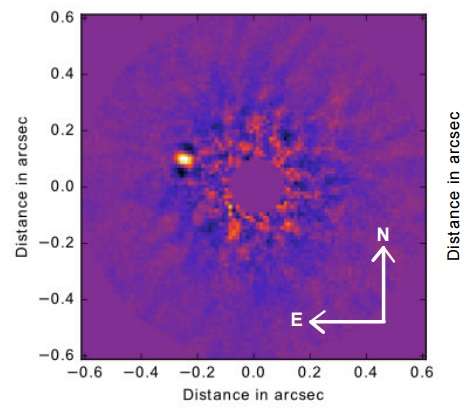December 12, 2016 report
Low-mass companion found inside debris disc of a nearby star

(Phys.org)—Astronomers have uncovered a new low-mass companion residing inside a massive debris disc surrounding a nearby star designated HD 206893. The discovery could provide new important clues on how low-mass stellar companions form and evolve. The findings were presented in a paper published Dec. 1 on the arXiv pre-print server.
Located some 125 light years away, HD 206893 is an F5V star hosting a debris disc detected through its large infrared excess. It is about 24 percent more massive than the sun and its age is estimated to be within the range of 200 million to 2.1 billion years. Due to its proximity and the presence of a debris disk, HD 206893's environment is an excellent place for astronomers to look for new stars and planets.
Recently, a team of researchers led by Julien Milli of the European Southern Observatory (ESO) in Chile has employed the observatory's Very Large Telescope (VLT) with the aim of finding new objects in the vicinity of HD 206893. The observations were carried out using VLT's SPHERE and NaCo imaging instruments in October 2015 and in August 2016, as a part of the SPHERE High Angular Resolution Debris Disc Survey (SHARDDS).
As a result of this observational campaign, the astronomers detected a faint object with a high contrast, orbiting its parent star very near – at about 10 AU.
"SPHERE opens a new discovery space for these systems because it is equipped with an extreme adaptive optics system that can beat the atmospheric turbulence and detect faint objects very close to their host star," Milli told Phys.org.
The newly detected object was designated HD 206893 B and is likely a brown dwarf with a mass between 24 to 73 Jupiter masses. However, the team does not exclude the possibility that the newly found object could be a giant planet. They key to confirm the real nature of this low-mass companion would be a more precise estimation of the host star's age.
"This is likely a brown dwarf but the conversion from the flux to a mass is difficult because we need to know the age of the star to make this conversion. Right now, the age is very little constrained, and it could be a young star of 200 million years, which would mean the brown dwarf is 24 Jupiter masses and close to a massive planet (13 Jupiter masses), or a medium-age star of two billion years, which would mean a 73 Jupiter-mass brown dwarf for the companion," Milli said.
It was also found by the team that HD 206893 B has a very red color, which suggests that its atmosphere is probably very dusty, since dust particles typically give a red color to the spectrum.
For now, the researchers will monitor the orbit of HD 206893 B, study the spectra and try to get an image of the debris disk with more details to study the relations between the companion and the disk.
"In parallel, we will try to refine the age of the star to better constrain the mass," Milli noted.
More information: Discovery of a low-mass companion inside the debris ring surrounding the F5V star HD206893, arXiv:1612.00333 [astro-ph.EP] arxiv.org/abs/1612.00333
Abstract
Uncovering the ingredients and the architecture of planetary systems is a very active field of research that has fuelled many new theories on giant planet formation, migration, composition, and interaction with the circumstellar environment. We aim at discovering and studying new such systems, to further expand our knowledge of how low-mass companions form and evolve. We obtained high-contrast H-band images of the circumstellar environment of the F5V star HD206893, known to host a debris disc never detected in scattered light. These observations are part of the SPHERE High Angular Resolution Debris Disc Survey (SHARDDS) using the InfraRed Dual-band Imager and Spectrograph (IRDIS) installed on VLT/SPHERE. We report the detection of a source with a contrast of 3.6x10^{-5} in the H-band, orbiting at a projected separation of 270 milliarcsecond or 10 au, corresponding to a mass in the range 24 to 73 Mjup for an age of the system in the range 0.2 to 2 Gyr. The detection was confirmed ten months later with VLT/NaCo, ruling out a background object with no proper motion. A faint extended emission compatible with the disc scattered light signal is also observed. The detection of a low-mass companion inside a massive debris disc makes this system an analog of other young planetary systems such as beta Pictoris, HR8799 or HD95086 and requires now further characterisation of both components to understand their interactions.
© 2016 Phys.org





















